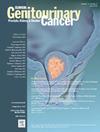肌肉浸润性膀胱癌三位一体治疗后的失败模式。
IF 2.3
3区 医学
Q3 ONCOLOGY
引用次数: 0
摘要
背景:肌肉浸润性膀胱癌(MIBC)患者接受三联疗法(TMT)治疗的实际结果,特别是失败模式,是有限的。我们的目的是评估典型异质人群中mbc TMT后失败的模式。方法:在国家退伍军人事务数据库中,2000-2018年期间接受明确意向TMT的尿路上皮组织学,MIBC (T2-4a/N0-3/M0)患者。TMT成功定义为≥50%的确定放射剂量和≥1个化疗周期。在多变量Fine-Gray模型中评估任何复发、转移性(非膀胱)复发(MR)和局部(膀胱)复发(LR)的终点。从辐射开始日期算起的复发次数。结果:在347例接受TMT治疗的MIBC患者中,65%的患者被认为不适合手术,35%的患者手术符合条件但选择了TMT。中位随访时间为77个月。中位总生存期为32.4个月(95% CI: 28.2-36.7)。154例(44%)患者无复发。130例(37%)患者发生MR,中位时间9.9个月。117例(34%)患者发生LR,中位时间8.7个月。在多变量模型中,淋巴结阳性(LN+)疾病(HR:3.31, 95% CI: 1.45-7.55, P < 0.01)和预处理肾积水(HR:1.62, 95% CI:1.11-2.36, P = 0.01)与mr的较高发生率相关。没有患者、肿瘤或治疗变量与LR相关。结论:在多机构和异质人群中,TMT是许多现实世界中MIBC患者的有效治疗方法。然而,相当比例的患者出现MR和/或LR,这强调了治疗后监测和改善治疗途径的必要性。确定的高风险特征(LN+疾病,预处理肾积水)和其他标记物应进一步研究,以确定TMT失败的高风险患者,因此可能从强化治疗(如额外的全身治疗)中获益。本文章由计算机程序翻译,如有差异,请以英文原文为准。
Patterns of Failure After Definitive Trimodality Therapy for Muscle-Invasive Bladder Cancer
Background
Real-world outcomes, especially patterns of failure, are limited for patients with muscle-invasive bladder cancer (MIBC) treated with trimodality therapy (TMT). We aim to evaluate patterns of failure after TMT for MIBC in a typical heterogeneous population.
Methods
In the national Veterans Affairs database, patients with urothelial histology, MIBC (T2-4a/N0-3/M0) who underwent definitive intent TMT between 2000-2018. Successful TMT was defined as ≥ 50% definitive radiation dose and ≥ 1 cycle chemotherapy. Endpoints of any recurrence, metastatic (nonbladder) recurrence (MR), and local (bladder) recurrence (LR) evaluated in multivariable Fine-Gray models. Times to recurrence calculated from radiation start date.
Results
In 347 patients with MIBC treated with TMT, 65% of patients were deemed ineligible for surgery while 35% were surgically eligible but elected for TMT. Median follow-up time was 77 months. Median overall survival was 32.4 months (95% CI: 28.2-36.7). 154 (44%) patients had no recurrence. 130 (37%) patients developed MR, median time 9.9 months. 117 (34%) patients developed LR, median time 8.7 months. In multivariable models, lymph node positive (LN+) disease (HR:3.31, 95% CI: 1.45-7.55, P < .01) and pretreatment hydronephrosis (HR:1.62, 95% CI:1.11-2.36, P = .01) were associated with higher rates of MR. No patient, tumor, or treatment variables were associated with LR.
Conclusions
Across a multi-institutional and heterogeneous population, TMT is an effective treatment for many real-world patients with MIBC. However, a notable proportion of patients develop MR and/or LR which emphasizes the need for post-treatment surveillance and improved treatment pathways. Identified high risk features (LN+ disease, pretreatment hydronephrosis) and other markers should be further investigated to delineate the patients at high risk of TMT failure who therefore may potentially benefit from augmented treatment, such as additional systemic therapy.
求助全文
通过发布文献求助,成功后即可免费获取论文全文。
去求助
来源期刊

Clinical genitourinary cancer
医学-泌尿学与肾脏学
CiteScore
5.20
自引率
6.20%
发文量
201
审稿时长
54 days
期刊介绍:
Clinical Genitourinary Cancer is a peer-reviewed journal that publishes original articles describing various aspects of clinical and translational research in genitourinary cancers. Clinical Genitourinary Cancer is devoted to articles on detection, diagnosis, prevention, and treatment of genitourinary cancers. The main emphasis is on recent scientific developments in all areas related to genitourinary malignancies. Specific areas of interest include clinical research and mechanistic approaches; drug sensitivity and resistance; gene and antisense therapy; pathology, markers, and prognostic indicators; chemoprevention strategies; multimodality therapy; and integration of various approaches.
 求助内容:
求助内容: 应助结果提醒方式:
应助结果提醒方式:


